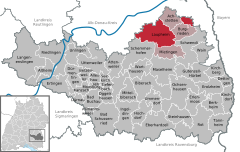
Back Laupheim ALS لاوبهايم Arabic لاوپهایم AZB Лаўпгайм BE Лаупхайм CE Laupheim (munisipyo) CEB Laupheim German Laupheim EO Laupheim Spanish Laupheim EU
Laupheim | |
|---|---|
 Chapel of St Leonhard | |
Location of Laupheim within Biberach district  | |
| Coordinates: 48°13′44″N 9°52′47″E / 48.22889°N 9.87972°E | |
| Country | Germany |
| State | Baden-Württemberg |
| Admin. region | Tübingen |
| District | Biberach |
| Subdivisions | 5 |
| Government | |
| • Lord mayor (2022–30) | Ingo Bergmann[1] (SPD) |
| Area | |
• Total | 61.80 km2 (23.86 sq mi) |
| Elevation | 528 m (1,732 ft) |
| Population (2022-12-31)[2] | |
• Total | 22,863 |
| • Density | 370/km2 (960/sq mi) |
| Time zone | UTC+01:00 (CET) |
| • Summer (DST) | UTC+02:00 (CEST) |
| Postal codes | 88471 |
| Dialling codes | 07392 |
| Vehicle registration | BC |
| Website | www |
Laupheim (German: [ˈlaʊphaɪm] ⓘ; Swabian: Laoba) is a major district town in southern Germany in the state of Baden-Württemberg. Laupheim was first mentioned in 778 and gained city rights in 1869. One of the main trading routes, from Ulm to Ravensburg and then on towards Lake Constance ran through Laupheim. Having developed from a rural settlement into a small urban area, Laupheim is home to a number of small to medium-sized industries and businesses. One of the largest employers are the German Armed Forces which maintain an airbase close to Laupheim, Laupheim Air Base.
Laupheim was the administrative centre of the district of Laupheim from 1842 until 1938 when the district was abolished. The southern parts of it were incorporated into the district of Biberach (including Laupheim itself) whereas the remainders were allocated to the district of Ulm.
In the second half of the 19th century Laupheim was home to the largest Jewish community in the Kingdom of Württemberg.
After World War II, Laupheim became part of the French occupation zone in 1945 and became part of the newly founded state of Württemberg-Hohenzollern in 1947.
Laupheim is the educational centre for the surrounding rural areas particularly with regards to secondary education.
- ^ Oberbürgermeisterwahl Laupheim 2022, Staatsanzeiger.
- ^ "Bevölkerung nach Nationalität und Geschlecht am 31. Dezember 2022" [Population by nationality and sex as of December 31, 2022] (CSV) (in German). Statistisches Landesamt Baden-Württemberg. June 2023.


